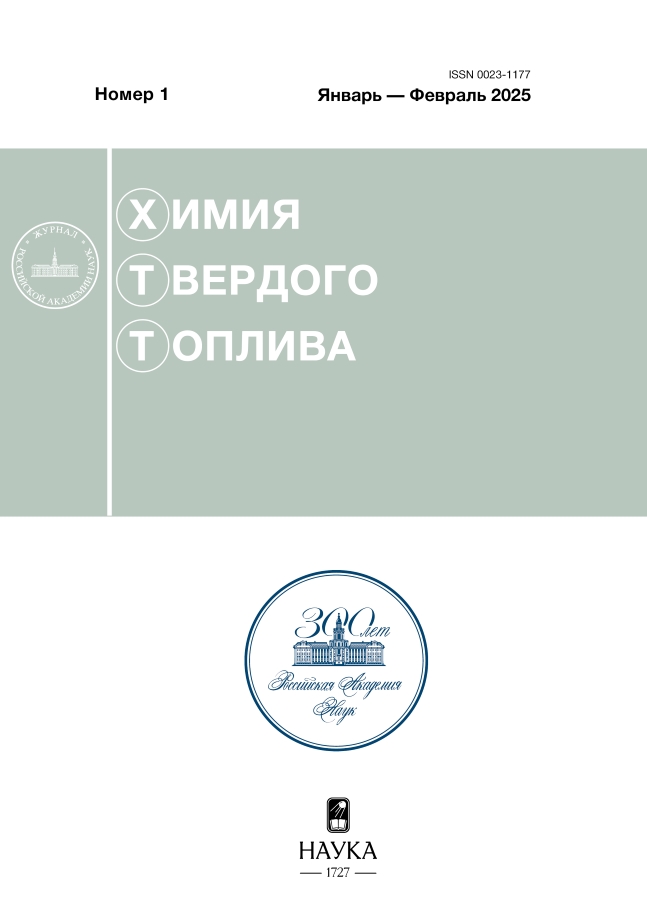Assessment of structural changes in resins and asphaltenes depending on the duration of cracking using structural group analysis
- Авторлар: Pevneva G.S.1, Voronetskaya N.G.1, Goncharov А.V.1
-
Мекемелер:
- Institute of Petroleum Chemistry, Siberian Branch, Russian Academy of Sciences
- Шығарылым: № 1 (2025)
- Беттер: 82-89
- Бөлім: Articles
- URL: https://kazanmedjournal.ru/0023-1177/article/view/684066
- DOI: https://doi.org/10.31857/S0023117725010119
- EDN: https://elibrary.ru/KTIPHM
- ID: 684066
Дәйексөз келтіру
Аннотация
Changes in structural parameters of secondary resins and asphaltenes formed upon the cracking of asphaltenes, resins and their mixture were assessed at different process durations. Resins and asphaltenes isolated from heavy methane crude of Zyuzeevskoye oil field (Tatarstan) and their mixture (Resins + Asphaltenes) were cracked in a closed reactor at 450°C for 60, 90 and 120 minutes. With increasing the duration of resins and asphaltene cracking, condensation reactions leading to an increase in the yield of coke and the formation of low-molecular-weight, highly aromatic secondary resin and asphaltene molecules accelerated. It was found that the directions of thermal transformations of resin and asphaltene molecules are similar. The joint presence of resins and asphaltenes in a mixture changed the direction on their thermal transformations in the course of cracking, which was reflected in the quantitative data on the mass balance and structural parameters of secondary resins and asphaltenes formed upon the cracking of a mixture of resins with asphaltenes. Differences in the structural characteristics of resins and asphaltenes formed upon the cracking of single-component samples and their mixtures were revealed.
Негізгі сөздер
Толық мәтін
Авторлар туралы
G. Pevneva
Institute of Petroleum Chemistry, Siberian Branch, Russian Academy of Sciences
Хат алмасуға жауапты Автор.
Email: voronetskaya@ipc.tsc.ru
Ресей, 634055 Tomsk
N. Voronetskaya
Institute of Petroleum Chemistry, Siberian Branch, Russian Academy of Sciences
Email: pevneva@ipc.tsc.ru
Ресей, 634055 Tomsk
А. Goncharov
Institute of Petroleum Chemistry, Siberian Branch, Russian Academy of Sciences
Email: mad111-2011@mail.ru
Ресей, 634055 Tomsk
Әдебиет тізімі
- Alvarez E., Marroquin G., Trejo F., Centeno G., Ancheyta J., Diaz J.A.I // Fuel. 2011. V. 90. № 12. P. 3602–3607. https://doi.org/10.1016/j.fuel.2010.11.046.
- Магарил Р.З. Теоретические основы химических процессов переработки нефти. Л.: КДУ, 2016. 279 с.
- Певнева Г.С., Воронецкая Н.Г., Копытов М.А. // Химия в интересах устойчивого развития. 2022. Т. 30. № 4. С. 406–412. https://doi.org/10.15372/KhUR2022396 [Chemistry for Sustainable Development. 2022. V. 30. № 4. P. 395–401. https://doi.org/10.15372/CSD2022396]
- Гринько А.А., Головко А.К // Нефтехимия. 2014. Т. 54. № 1. С. 43–49. https://doi.org/10.7868/S0028242113040059 [Petroleum Chemistry. 2014. V. 54. № 1. P. 42–47. https://doi.org/10.1134/S0965544113040051]
- Pham H.H., Ngoc Thuy Nguyen, Kang Seok Go, Sunyoung Park, Nam Sun Nho, Gyoo Tae Kim, Chul Wee Lee, Felix G. // Catalysis Today. 2020. V. 353. P. 112–118. https://doi.org/10.1016/j.cattod.2019.08.031
- Ancheyta J., Centeno G., Trejo F., Marroquin G. // Energy & Fuels. 2003. V. 17. № 5. P. 1233–1238. https://doi.org/10.1021/ef030023+
- Певнева Г.С., Воронецкая Н.Г., Гончаров А.В., Корнеев Д.С. // Solid Fuel Chemistry. 2024. V. 58. № 2. P. 111–116. https://doi.org/10.3103/S0361521924020113.
- Patrakov Yu.F., Kamyanov V.F., Fedyaeva O.N. // Fuel. 2005. V. 84. № 2–3. P. 189–199. https://doi.org/10.1016/j.fuel.2004.08.021.
- Корнеев Д.С., Певнева Г.С., Воронецкая Н.Г. // Нефтехимия. 2021. Т. 61. № 2. С. 172–183. https://doi.org/10.31857/S0028242121020052 [Petroleum Chemistry. 2021. V. 61. no. 2. P. 152–161. https://doi.org/10.1134/S0965544121020158]
- Певнева Г.С., Воронецкая Н.Г., Корнеев Д.С., Головко А.К. // Нефтехимия. 2017. Т. 57. № 4. С. 479–486. https://doi.org/10.7868/S0028242117040128 [Petroleum Chemistry. 2017. V. 57. № 8. P. 739–745 https://doi.org/10.1134/S0965544117080126]
Қосымша файлдар









